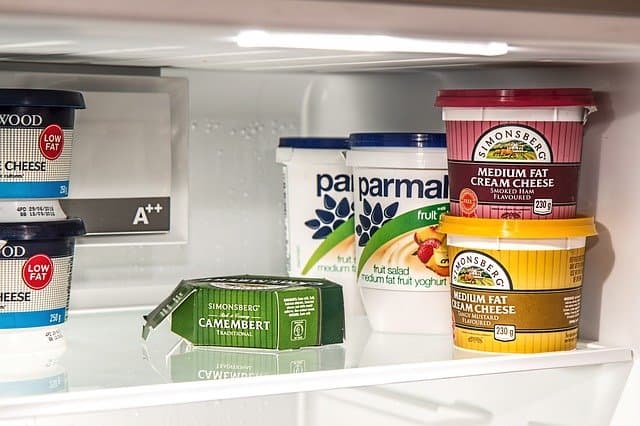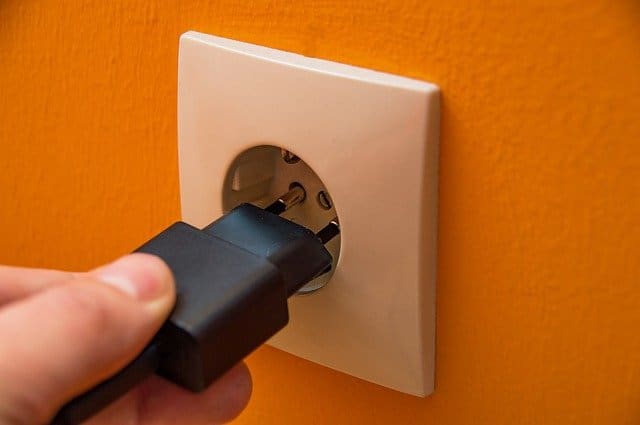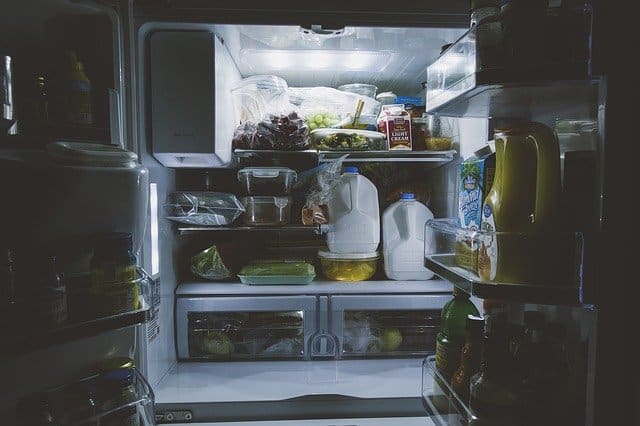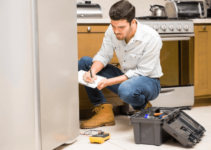Last Updated on October 20, 2022 by E.Pery
When refrigerators stop cooling perishables, most people panic and call technicians immediately. However, not all cooling problems require the assistance of a repairman.
There are several reasons why your fridge isn’t staying cold, some of which you can fix. It would help if you had a handful of essential tools and a primary process of diagnosis that will help you identify the root cause.
This guide will help you to troubleshoot the problem with your refrigerator and offer you a few fixing tips that you could use to bring it back to life before you make that call.

12 Reasons Your Refrigerator Is Not Cooling
If your refrigerator is not cooling, you should check the basic stuff first. Performing these easy fixes could save you unnecessary service fees or help the repairman save time by quickly identifying the problem.
- Is the refrigerator plugged in?
- Has the thermostat been turned down?
- Is the door closing properly?
- Is cold air circulating properly?
- Dirty condenser coils
- Blocked vents
- Refrigerator part failure
- Damaged control boards
- Broken condenser fan motor
- An evaporator fan motor that is not working
- Malfunctioning thermostat
- Faulty start capacitor
1. Is the Refrigerator Plugged in?
A refrigerator cannot work without power. So the first thing you should check when your fridge stops working is whether it is plugged into a power source.

If the power code is plugged in but the refrigerator is still not receiving power, check whether the circuit breaker is tripped or the electrical outlet is damaged.
You should also check whether the refrigerator’s power cord is damaged. The last thing you want to do is call the technician when the power cord is not plugged in.
Recommended reading: How Does A Refrigerator Work?
2. Has the Thermostat Been Turned Down?
If your refrigerator won’t cool and your ice maker has production issues, your thermostat may be the issue. A new fridge will usually come preset at a temperature between 35 and 37 degrees F. This temperature range is optimal for a refrigerator to preserve perishable food.
Recommended reading: What Temperature Should A Refrigerator Be?
However, sometimes the thermostat dials in the fridge are bumped into by storage containers and other items such as milk cartons, changing the set temperature. Exterior digital thermostats can also be adjusted when someone leans against the control panel.
So, if your refrigerator is not cooling, check the thermostat and reset the temperature to the safe zone. You should also reset the temperature settings in your freezer compartment if necessary and lock the scenes to prevent future alterations.
3. Is the Door closing Properly?
If your refrigerator is not working even when plugged in and the thermostat is well set, check whether the door is closing correctly. Check whether the lights in the fridge are turning off when you close the refrigerator.
Sometimes gaskets, the elastic strips on the edges of the door designed to seal it tightly, can wear off or tear. When they do, they leak warm air into the fridge.
If the door isn’t closing correctly, you know that that could be the problem. But if it is, you should check the circulation of air in the fridge.
4. Is Cold Air Circulating Properly?
When your fridge is too full, cold air is obstructed from circulating through the refrigerator. Poor circulation is a common cause of your refrigerator not cooling. So, if the fridge is too full, clear out some food and organize it to improve circulation.
Once you have checked the basics and established they are not the problem, you can now diagnose the problem by exploring other factors that could cause your refrigerator to not cool.
5. Dirty Condenser Coils
The refrigerator works by cooling food by passing cold air through it and expelling warm air through the condenser coil. When the condenser coil of your fridge is dirty, it works harder to release the heat. The dirt on the condenser coil affects the performance of the refrigerator.
So, if your refrigerator is not cooling correctly, try cleaning the condenser coil. A clean condenser coil can release heat from the fridge without much hassle.
Recommended reading: How To Clean Refrigerator Coils?
6. Blocked Vents
The temperature within the fridge is kept optimum through air circulation facilitated by internal and external vents. These vents must be kept open to ensure that the temperature within the refrigerator is consistent.
When storage containers or the external ones obstruct internal vents and are blocked by objects such as grocery bags or boxes, they prevent warm air from being expelled, thereby altering the temperature in the fridge.
Vents can also be blocked by dirt. So it is essential to clean them as many times as possible.
7. Refrigerator Part Failure
Part failure could also be a cause of your refrigerator not cooling. Component malfunctions could cause refrigerating problems that might require appliance repair. Below are common part failures that cause refrigerator problems.
8. Damaged Control Boards
Most modern refrigerators have at least two circuit boards; the temperature control board and the main control board. When either one or both are damaged, the refrigerator temperature could be seriously affected.
You may not be able to diagnose temperature issues or repair the fridge by yourself. So if you suspect a control board failure, it is best for you to contact a technician.
9. Broken Condenser Fan Motor
A damaged condenser fan could also be a cause for your refrigerator not cooling. The condenser fan motor draws air over the condenser coils to cool them. This function prevents the fridge from overheating.
The condenser fan motor is located underneath or behind the refrigerator. Reach out to it and check whether it’s working or not. If it is not working, call a professional to repair it as soon as possible to prevent food loss.
10. An Evaporator Fan Motor That is Not Working
Refrigerators have one or more evaporator fan motors depending on the model. If the appliance you have has only one evaporator fan motor, it’s likely located in the freezer compartment.
The evaporator fan motor circulates cold air from the evaporator coils to the rest of the fridge. Hence, if this fan motor fails to work, cool air won’t spread throughout the refrigerator.
11. Malfunctioning Thermostat
A faulty thermostat is often unable to signal the compressor when there is a need for additional cool air.
12. Faulty Start Capacitor
The compressor needs the capacitor to provide it with the voltage necessary to enable it to produce cool air. Without it, the compressor won’t start, and the refrigerator will not cool.
How to fix a refrigerator that is not cooling? [3 easy steps]
- Clean your refrigerator
- Test your fridge’s thermostat
- Reset your refrigerator compressor
1. Clean Your Refrigerator
If your refrigerator is not cooling, but the light is on, the coil may be dirty. You can clean the coil using a long brush or a vacuum cleaner.
How to Clean Dirty Condenser Coil [7 easy steps]
- The first thing you need to do before cleaning a dirty condenser is unplug the fridge.
- Then, you need to drag it out of an enclosed area to access the rear of the refrigerator. The condenser is the coil with a section of aluminum fins connected to a fan motor.
- Remove the grill covering the condensing unit using a Phillips head screwdriver.
- Remove dust from the coil with a vacuum cleaner to access the face of the condenser.
- Remove any remaining dust from the coil with a counter brush.
- Spray the coil with a non-rinse foam and let it sit for at least half an hour.
- Remove the residual on the coil with a rag from the baseplate of the condensing unit.
It would be best if you cleaned the condenser coil once or more times a year. Cleaning the condenser coil maximizes the efficiency of your refrigerator and prevents future failures.
Recommended reading: How To Clean Stainless Steel Refrigerator [10 Methods]
How To Clean A Refrigerator? [12 Easy Steps]
2. Test Your Fridge’s Thermostat
As mentioned above, a malfunctioning thermostat could be a cause for your refrigerator not cooling. The thermostat is a small plastic compartment with a temperature dial on the front part.
A thermostat is an electrical switch that is controlled by a bulb. This bulb senses the temperature in the refrigerator. When the temperature rises beyond the desired point, the controller is activated and completes the electrical circuit.
When the contacts on the switch malfunction due to damage by heat, they prevent the switches from closing. Here is a step-by-step guide on how to test the thermostat of your fridge.
How to Test the Thermostat of Your Fridge [6 easy steps]
- Turn the power off and unplug the refrigerator.
- Remove the plastic enclosure covering the thermostat to access the terminals.
- Take a photo of the thermostat with the wiring still connected using your smartphone.
- Remove the wiring and use a multimeter to test the functionality of the switches.
- Set the multimeter and connect either of the probes to each of the terminals.
- Rotate the temperature dial to the lowest point. Check whether the switch makes a complete circuit. If the switch is functioning correctly, the thermostat will release a continuous beeping sound.
Note that if you break the bulb when undertaking this procedure, the system will be utterly useless.
3. Reset Your Refrigerator Compressor
If your condenser coil is dirty, it may have tripped the compressor on thermal overload. You need to wait for at least four hours before restarting the compressor.
How Do I Reset My Refrigerator Compressor [3 easy steps]
- Clean the condenser coil
- Allow the compressor to cool down
- Turn the power off for 30 seconds and then turn it on again.
How do you know if your refrigerator compressor is bad?
- Locate the compressor’s electrical terminal box on the compressor’s body.
- Remove the terminal box cover and take a photo of the terminals while the wiring is still connected.
- Remove the wires from each terminal.
- Measure the resistance (in ohms) between each winding and record the sum of each with one probe connected between the start and run winding and another between the beginning and the common winding.
- Once you get the three readings, start, common and run, ensure that the resistance between each start and run winding is equal to the beginning and common winding.
If the readings fail to add up, the compressor is faulty and needs replacement.
Recommended reading: Which Refrigerator Brand Is Most Reliable?
8 Refrigerator Brands To Avoid [3 To Consider]
Refrigerator Buying Guide
How to replace the refrigerator evaporator fan?
A faulty evaporator fan could be another reason for your refrigerator not cooling. One of the signs that the evaporator fan has stopped working is when your compressor is running but the fridge is not cooling.
This problem occurs when frost breaks or clogs the evaporator fan and evaporator coils, respectively. When the evaporator begins to get faulty, it produces squeaky noises.
The noise gets louder when you open your freezer door because the evaporator fan and coils are located in the freezer compartment.
How to replace Faulty Evaporator Fan
- Remove the cover at the back of the freezer
- Remove the fan cover
- Remove the evaporator fan
- Replace the fan
- Replace the evaporator condenser fan and install a new fan.
How much does it cost to fix a refrigerator that is not cooling?
It’s impossible to get an accurate answer to this question, but getting estimates could enable you to have a rough idea of how much you expect to part with, depending on the problem with your fridge.
Suppose you pay the repairman by the hour for diagnosis and repair services such as cleaning the condenser coil or replacing the thermostat.
In that case, you might be looking at 150-200 dollars before any component replacement. However, if the refrigerator has more severe issues, you might part with at least $1200.
As discussed in previous sections, you could reduce your refrigerator repair cost by performing some labor-intensive tasks yourself.
These tasks include leak testing or compressor replacement. Cleaning the condenser is not worth the money you might be charged.
Recommended reading: How Much Does A Refrigerator Cost?
How Many Watts Does A Refrigerator Use?
Rough replacement for minor repair works
- Evaporator fan motor replacement $470.00
- Coil clean and condenser fan motor replacement – $580.00
- PCB control board replacement $850.00
- Thermostat replacement and calibration $380.00
- Run and or start capacitor replacement $355.00
Bottom line
This guide provides you with a few tips on why your refrigerator is not cooling. However, there are many more problems that fridges experience, some of which require the assistance of a technician.
The best way of avoiding the need for repairs and replacement before your refrigerator’s lifespan ends is by conducting routine maintenance.

E Pery is the founder of refrigerator.deals and a webmaster. He runs his own websites and loves… refrigerators! Convinced that buying and maintaining a refrigerator is not easy, he decided to create refrigerator.deals, in order to help people make the right choices.








![8 Refrigerator brands to avoid [3 to consider]](https://refrigerator.deals/wp-content/uploads/2021/08/Refrigerator-Brands-To-Avoid-211x150.jpg)
![How To Defrost A Refrigerator? [6 simple methods]](https://refrigerator.deals/wp-content/uploads/2021/08/How-To-Defrost-A-Refrigerator--211x150.jpg)
